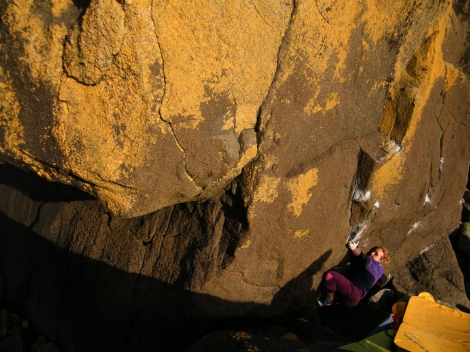On my first acquaintance with Ropes of Maui (8B) I thought this is really quite hard and I will need to improve my climbing to do it. One or two of the moves I couldn’t do, and I could see it as being a decent winter project. I’d try other boulders, get stronger and have to keep on coming back.
I find its harder to get your head around the idea of ‘learning the moves’ on a boulder problem, than it is on a route. Moves on routes generally aren’t as hard and climbing them becomes more a question of climbing more etc once you know the moves, then, before you know it, the moves are feeling easy. But when you can’t do moves its hard to comprehend how all of a sudden your body will be able to do them, and then not just do them, link them into other moves you also couldn’t do the day before yesterday.
When I first began trying to climb Ropes I was excited about the changes in my climbing which might have to occur between then and doing it But I topped/ crawled out on my 4th session, and nothing had changed.
Driving home I felt less satisfaction having done it then on previous sessions when I’d left feeling tired, knowing that the tiredness was good for me etc. Getting further and further along the sequences you really feel like you are progressing and you have something to measure yourself against. By failing you are naturally and by definition reaching your limit, which is a really nice feeling. It’s good to know your trying hard, so perhaps when we succeed, this whole phenomenon where by the ‘process’ is more enjoyable than the end result is because of this; the fact that we haven’t actually pushed ourselves to our limits that day?
Climbing is not all about improving, or performance the only source of satisfaction, but a large part of it definitely is, and bouldering definitely takes up a good proportion of this part.This side of climbing is often frowned upon, climbers being shy about admitting they might have just climbed something because it’s hard, and they find that fun. Gymnasts perform routines in order to achieve high scores, so why can’t climbers perform routines in order to achieve high grades? Personally however there does have to be some aesthetics and quality involved.
Performance is important, and as shown it can be hard to gauge. When I’m going well in one area of climbing I can feel like I’m neglecting other parts, and that I’m just doing what’s easy for me. For example, if I’m bouldering well I think ‘yeah your strong but I bet you wouldn’t cruise up 40m of jugs’ and by just keeping on bouldering I’m taking the easy way out of getting fit, just feeding my ego. Then 3 months of sport climbing later the same applies and I think ‘yeah but your weak now aren’t you’.
In climbing Ropes of Maui I guess I was quite simply trying to find a set of moves, which once climbed would have forced a change in my climbing and I guess shamefully act as a measure of my performance. I was pretty chuffed to when I pulled out the hole. It’s a great set of moves, something I imagine finding in Switzerland, and whilst the setting isn’t exactly the Mallory Boulder, there is definitely something special about climbing in the Pass, in the rain.
Here is an unrelated picture that I like…
